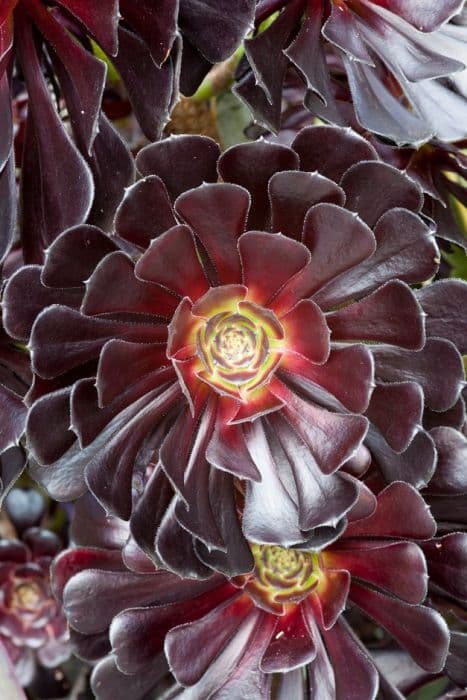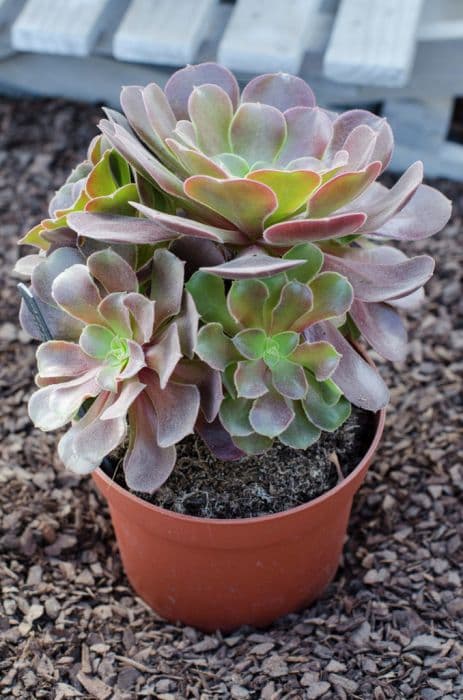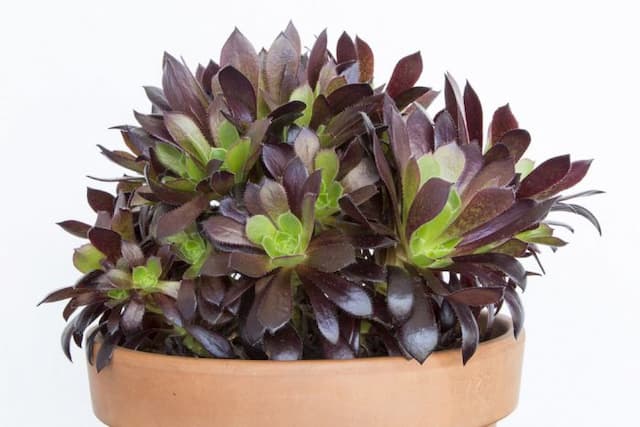Stonecrop Hylotelephium 'Abbey Dore'

ABOUT
The 'Abbey Dore' is a succulent perennial known for its striking foliage and showy flower heads. It features thick, fleshy leaves that form a rosette pattern. The leaves are often a bluish-green or gray-green color, providing a striking contrast against the warmer tones in the garden. During the blooming season, the plant boasts large, flat-topped clusters of tiny, star-shaped flowers. These flowers are typically a vibrant pink or pale purplish-pink hue, attracting butterflies and other pollinators to the garden. As the season progresses, the blooms may deepen in color, providing visual interest throughout its flowering period. The 'Abbey Dore' has a robust and upright growth habit, which creates a mound-like presence in garden spaces.
About this plant
 Names
NamesFamily
Crassulaceae
Synonyms
Stonecrop, Orpine, Live Forever
Common names
Hylotelephium 'Abbey Dore'.
 Toxicity
ToxicityTo humans
Sedum 'Abbey Dore,' commonly known as stonecrop, is not typically considered toxic to humans. However, it’s always prudent to avoid ingesting parts of ornamental plants as they are not intended for consumption and individual sensitivities to plant compounds can vary. Ingestion of non-edible plants can sometimes cause mild gastrointestinal upset such as nausea, vomiting, or diarrhea.
To pets
Stonecrop is also generally not considered highly toxic to pets. However, as with humans, ingestion of plant material by pets should be avoided as it can potentially cause gastrointestinal upset, including symptoms like vomiting and diarrhea. If a pet is known to have consumed a significant amount of the plant and is showing signs of distress, it is best to consult a veterinarian.
 Characteristics
CharacteristicsLife cycle
Perennials
Foliage type
Deciduous
Color of leaves
Green
Flower color
Pink
Height
1-2 feet (30-60 cm)
Spread
1-2 feet (30-60 cm)
Plant type
Succulent
Hardiness zones
5
Native area
Asia
Benefits
 General Benefits
General Benefits- Easy to Grow: Hylotelephium 'Abbey Dore', commonly known as Stonecrop, is known for being low-maintenance and easy to cultivate in a variety of conditions, which is ideal for novice gardeners or those looking for carefree landscaping options.
- Drought Tolerant: Stonecrop has succulent leaves that store water, allowing the plant to thrive in dry, drought-like conditions where other plants might wither.
- Attracts Pollinators: The flowers of Stonecrop are attractive to bees, butterflies, and other pollinating insects, which help to support local ecosystems and biodiversity.
- Seasonal Interest: With its attractive foliage and vibrant flowers, Stonecrop offers aesthetic appeal from late spring to autumn, adding color and interest to the garden through multiple seasons.
- Suitable for Containers: This versatile plant can be grown in containers, making it a great choice for patios, balconies, or areas where garden space is limited.
- Erosion Control: Stonecrop has a spreading habit and can help stabilize soil and prevent erosion on slopes or in rocky areas.
- Versatile Design Uses: With its unique texture and form, Stonecrop can be used in various garden designs such as rock gardens, borders, or groundcovers, providing creative options for gardeners.
 Medical Properties
Medical PropertiesThis plant is not used for medical purposes.
 Air-purifying Qualities
Air-purifying QualitiesThis plant is not specifically known for air purifying qualities.
 Other Uses
Other Uses- The thick foliage of Hylotelephium 'Abbey Dore', commonly known as Stonecrop, can be used as a living mulch in garden beds to suppress weeds and retain soil moisture.
- Stonecrop's dense mat-forming growth habit provides excellent ground cover to reduce soil erosion on slopes or in areas prone to heavy rains.
- The plant can be used in green roofing projects due to its drought tolerance and ability to thrive in shallow soil, thus contributing to urban heat island mitigation.
- Dried stems and flowers of Stonecrop can be incorporated into floral arrangements for a rustic, long-lasting element.
- Stonecrop can be planted in containers with other drought-resistant species to create low-maintenance and water-wise patio gardens.
- The succulent leaves of Stonecrop can be added to living walls or vertical gardens for texture and visual interest.
- Stonecrop is suitable for xeriscaping gardens due to its low water requirement, making it ideal for regions with water restrictions or low rainfall.
- Gardeners can propagate Stonecrop easily from cuttings, providing an inexpensive way to expand garden plants or share with friends.
- In colder regions, Stonecrop can serve as winter interest in the garden due to its persistent structure even after the first frosts.
- Stonecrop can attract pollinators such as bees and butterflies, enhancing pollination in the garden and supporting local ecosystems.
Interesting Facts
 Feng Shui
Feng ShuiThe Sedum 'Abbey Dore' is not used in Feng Shui practice.
 Zodiac Sign Compitability
Zodiac Sign CompitabilityThe Sedum 'Abbey Dore' is not used in astrology practice.
 Plant Symbolism
Plant Symbolism- Adaptability: Hylotelephium 'Abbey Dore', commonly known as Stonecrop, is known for its ability to thrive in a variety of harsh conditions, symbolizing adaptability and resilience in life's challenging circumstances.
- Persistence: Stonecrop has a tenacious quality, often continuing to grow in rocky and nutrient-poor soils, representing the trait of persistence and determination to grow despite difficulties.
- Survival: With its succulent leaves that store water, Stonecrop symbolizes the importance of conservation and survival, as it can withstand long periods of drought.
- Peace: Often found gracing gardens with its calming presence, Stonecrop can signify tranquility and peace in one's environment or life.
- Beauty: The vibrant flowers of the Stonecrop plant, which bloom in the summer, represent beauty and the ability to flourish and stand out in the midst of austerity.
 Water
WaterStonecrop plants, including the 'Abbey Dore' variety, require minimal watering due to their drought-tolerant nature. During the growing season, water approximately once every two weeks, provided there has been no significant rainfall. Each watering session should be thorough, soaking the soil to a depth of one inch. During the winter months, reduce watering to once a month, as the plant’s water requirements decrease significantly. Overwatering can lead to root rot, so it is crucial to allow the soil to dry out between watering sessions.
 Light
LightStonecrop 'Abbey Dore' thrives best in full sun to partial shade conditions. The ideal spot for this succulent is an area where it can receive at least 6 hours of direct sunlight daily. When grown indoors, place it near a south-facing window where it will get plentiful light. In extremely hot climates, some afternoon shade will help prevent scorching of the leaves.
 Temperature
TemperatureStonecrop 'Abbey Dore' is a hardy plant that can tolerate a wide range of temperatures but performs best when the temperature is between 65°F and 75°F. It can withstand freezing temperatures down to around -30°F and is heat-tolerant up to approximately 90°F. The plant will go dormant in winter but can survive the cold with adequate drainage to prevent water from freezing around the roots.
 Pruning
PruningPruning stonecrop 'Abbey Dore' helps maintain its shape and encourages new growth. Remove dead or damaged stems and spent flower heads in early spring or after flowering to stimulate the next year's growth. Cutting back the plants in late fall or early winter after the foliage has died back is also advisable to keep the garden tidy. Prune every year to ensure robust plants and abundant blooms.
 Cleaning
CleaningAs needed
 Soil
SoilThe best soil mix for Stonecrop 'Abbey Dore' is a well-draining mixture with equal parts potting soil, coarse sand, and perlite or pumice. This plant prefers a slightly acidic to neutral pH, ranging from 6.0 to 7.0.
 Repotting
RepottingStonecrop 'Abbey Dore' should be repotted every 2-3 years to refresh the soil and accommodate root growth. It's best to repot in the spring before active growth begins.
 Humidity & Misting
Humidity & MistingStonecrop 'Abbey Dore' thrives in low to average humidity conditions and does not require high humidity; typical indoor levels are usually sufficient.
 Suitable locations
Suitable locationsIndoor
Place in bright light, allow soil to dry between waterings.
Outdoor
Full sun; well-drained soil; tolerate drought once established.
Hardiness zone
3-9 USDA.
 Life cycle
Life cycleThe life of Hylotelephium 'Abbey Dore', commonly known as Stonecrop, begins with seed germination, where seeds sprout in warm, moist soil in spring or early summer. The seedlings develop a simple root system and foliage, maturing into rosette-formed clumps of succulent leaves that grow close to the ground. Throughout the growing season, the plants expand and form a dense mat of succulent leaves, and in the second year, they start to produce upright flowering stems. Blooming typically occurs in late summer to early fall, with clusters of small, star-shaped flowers that attract pollinators such as bees and butterflies. After pollination, seeds develop and are dispersed near the parent plant or by wind. The plant is perennial and will go dormant in winter, retracting energy to the roots to survive cold temperatures, before resuming growth in the spring.
 Propogation
PropogationPropogation time
Early Spring to Summer
The Hylotelephium 'Abbey Dore', commonly known as a variety of Stonecrop, is best propagated through stem cuttings. The ideal time for this process is late spring to early summer when the plant is in active growth. To propagate by stem cuttings, a gardener should select a healthy stem and cut a 2 to 4-inch (5 to 10 cm) section. The cut end of the stem can be let to callous over for a day or two to prevent rot when planted. Then, the cutting should be placed in well-draining soil, keeping it moist until roots develop, which usually takes a few weeks. Rooting hormone can be used but isn't essential for Stonecrop, as it roots readily. Once established, the young plant can be treated as a mature specimen.









